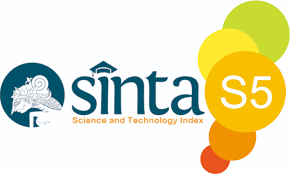Aplikasi Pengolahan Data Permintaan dan Pengeluaran Material Teknik di Perusahaan Umum Daerah Tirta Hidayah Kota Bengkulu Berbasis Web
Abstract
Tirta Hidayah, Bengkulu City, distributes water to customers using pipes and engineering materials designed to work properly. However, this does not always run smoothly, because technical and non-technical problems often occur. To carry out the process of handling and correcting problems that occur in the field, each department must order goods in the warehouse. However, the problem is that the location between offices is quite far and the administration is quite long, making the demand and expenditure of goods not optimal and has an impact on customer service. Of course, this situation can hamper service to customers, because the currently available applications can only be accessed offline. Therefore, the author is interested in creating a web-based application for the PHP programming language and Mysql database. The system development was carried out using the waterfall SDLC model, with the result that the application for processing data on demand and expenditure of engineering materials with a web-based system at the Tirta Hidayah Regional Public Company, Bengkulu City, which was built has been running well, and this application is useful and helps the Service Unit (Processing, Transmission and Distribution Installation, New Installation) and Warehouse Sub Division and Tirta Hidayah General Section of Bengkulu City in the process of requesting and releasing technical materials to be more effective and efficient
Downloads
References
[2] Asropudin, P. (2013). Kamus Teknologi Informasi Komunikasi. Bandung: Titian Ilmu.
[3] Baridwan, Z. (2018). Sistem Akuntansi Penyusunan Prosedur dan Metode. Yogyakarta: BPPE.
[4] Hidayatullah. (2017). Pemrograman WEB Edisi Revisi. Bandung: Informatika.
[5] Indrajani. (2015). Database Design. Jakarta: Elex Media Komputindo.
[6] Jogiyanto. (2011). Analisis dan Desain Sistem Informasi, Sistem Informasi: Pendekatan Terstruktur Teori dan Praktik Aplikasi Bisnis. Yogyakarta: Andi Ofset.
[7] Kristanto, A. (2018). Perancangan Sistem Informasi dan Aplikasi. Yogyakarta: Gaya Media.
[8] Kurniawan, W. J. (2017). Sistem Informasi Pengelolaan Laboratorium Komputer UPI-YPTK Padang. Jurnal Edik Informatika, 2(1), 25-33.
[9] Muharam, A. (2018). 5 Keunggulan Aplikasi Web yang Harus Anda Ketahui. Dipetik Oktober 10, 2021, dari https://www.logique.co.id/blog/2018/07/27/keunggulan-aplikasi-web/.
[10] Nisa, F. Y. (2014). Permintaan Dalam Ekonomi Mikro. Edunomic Jurnal, 1(2), 15-24.
[11] Prasojo. (2011). Pengantar Sistem Informasi Manajemen. Bandung: Remadja Karya.
[12] Raharjo, B. (2011). Belajar Otodidak Membuat Database Menggunakan MySQL. Bandung: Informatika
[13] Santoso, Rahmatuloh, M., & Susanti, N. (2018). Aplikasi pengolahan data barang keluar pada Gudang Sepatu dengan metode Fifo. Jurnal Teknik Informatika, 10(2), 20-26.
[14] Sari, I. P. (2019). Aplikasi pengolahan data stok material pada CV Seragam Jaya Teknik berbasis web. Politeknik Palcomtech, 4(2), 7-19.
[15] Shalahuddin, M., & Rosa, A. S. (2015). Rekayasa Perangkat Lunak Terstruktur dan Berorientasi Objek. Bandung: Informatika.
[16] Sonata, R., & Rochmawati, N. (2017). Sistem Informasi Manajemen Laboratorium Teknik Informatika Universitas Negeri Surabaya. Jurnal Manajemen Informatika, 7(2), 1-10.
[17] Sutabri, T. (2012). Analisis Sistem Informasi. Yogyakarta: Andi Ofset.
[18] Syafarina, G. A. (2016). Perancangan aplikasi inventory barang materials dan product. Technologia, 7(1), 25-33.
[19] Tata, & Shinroku. (2005). Pengetahuan Bahan Teknik. Jakarta: Prandnya Paramita.
Copyright (c) 2024 Yuza Reswan, Muntahanah Muntahanah, Eka Sahputra, Yolan Pagestu

This work is licensed under a Creative Commons Attribution-ShareAlike 4.0 International License.
An author who publishes in Jurnal Media Infotama agrees to the following terms:The author holds the copyright and grants the journal the right of first publication of the work simultaneously licensed under the Creative Commons Attribution-Share Alike 4.0 License which allows others to share the work with acknowledgment of the work's authorship and initial publication in this journal.Submission of a manuscript implies that the submitted work has not been previously published (except as part of a thesis or report, or abstract); that it is not being considered for publication elsewhere; that its publication has been approved by all co-authors. If and when a manuscript is accepted for publication, the author retains the copyright and retains the publishing rights without limitation.
For new inventions, authors are advised to administer the patent before publication. The license type is CC-BY-SA 4.0.
MEDIA INFORMATION REVIEW: Journal of the Faculty of Computer Science is licensed under a Creative Commons Attribution-ShareAlike 4.0 International License.You are free to:Share
— copy and redistribute material in any medium or formatAdapt
— remix, modify and develop materialfor any purpose, even commercial.
The licensor cannot revoke this freedom as long as you follow the license terms












.png)


